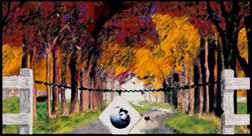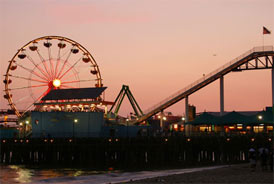![]() 2009.Sept.27 » The Bug rode a bike for the first time this week. I mean » a 2-wheeler, without training wheels. One of the major milestones on the road to manhood.
2009.Sept.27 » The Bug rode a bike for the first time this week. I mean » a 2-wheeler, without training wheels. One of the major milestones on the road to manhood.
 The Bug Rides .. without Training Wheels!
The Bug Rides .. without Training Wheels!
I was excited (.. even more than he was) .. running alongside, shouting » "Oh my God! You're riding!" Waiving my arms like an idiot.
But later disappointed. Cuz I had anticipated spending a few days teaching him. Instead, he just hopped on and rode off (.. his very first try).
I didn't say anything, but was thinking, "Doncha know you're supposed fall & crack your noggin a few times .. like I did?"
I've been talking to various dads the past few weeks, learning different techniques on how to teach him to ride ...
.. such as » remove the pedals & let him push himself along, allowing him to become accustomed to the bike's balance at his own pace .. or » grab him by a snug-fitting t-shirt between the shoulder blades and run alongside .. again, giving him most of the balance .. and also » the 'broomstick technique.'
Riding a bike is all about » balance. I think the reason he picked it up so quickly is cuz he's been riding a 2-wheel scooter around town the last few weeks. It's actually called » a razor. (He's a little demon on that razor.)
Today's entry concludes in Ye Olde Rad Blog III .. see here » The Bug Rides .. without Training Wheels!
![]() 2009.Sept.22 » Autumnal equinox today. The exact moment when the sun crosses the equator (heading south) = 9:18 PM UTC, which = 2:18 PM Pacific Daylight.
2009.Sept.22 » Autumnal equinox today. The exact moment when the sun crosses the equator (heading south) = 9:18 PM UTC, which = 2:18 PM Pacific Daylight.
 Autumn Begins .. with a Single Drop
Autumn Begins .. with a Single Drop
National Geo says » 5:19 AM Eastern (which = 2:19 AM PDT), so I think they type-o'ed AM, when they meant PM.
Nevertheless, it's still the best page I've seen yet on the subject .. cuz it explains why there's not (yet) 12 hours of (equal) day & night. Cool video, too.
Just noticed I used a picture of a spigot dripping water in yesterday's entry (» re: Conditional Love, near the end) ..
..
while a photo (using high-speed photography) shows a droplet hitting the surface in the entry directly below it (» New Layout Design, posted 9/15), which I used to represent LIQUID designs.
The two entries therefore look connected, don't they? But aren't. Two completely unrelated subjects .. made nearly a week apart. Totally did not plan it that way. At least, I don't think I did. (I'm not that clever.) Must be a coincidence.
Update - I truncated the previous entry cuz it was getting long, and posted the remainder (including the spigot) here » Conditional Love = Manipulation.
![]() 2009.Sept.21 » An article posted in last week's NY Times has been gnawing at me all weekend. It cites a study performed by two Israelis & a "leading American expert on the psychology of motivation." The single-page piece is titled » "When a Parent's Love Comes with Conditions" .. or » "When 'I Love You' means 'Do as I Say'."
2009.Sept.21 » An article posted in last week's NY Times has been gnawing at me all weekend. It cites a study performed by two Israelis & a "leading American expert on the psychology of motivation." The single-page piece is titled » "When a Parent's Love Comes with Conditions" .. or » "When 'I Love You' means 'Do as I Say'."
 Conditional Love = Manipulation
Conditional Love = Manipulation
The article can be summed with the following quote:
"The primary message of all types of conditional parenting is that children must earn a parent’s love. A steady diet of that, Rogers warned, and children might eventually need a therapist to provide the unconditional acceptance they didn’t get when it counted."
Doesn't it seem odd that a study was required to determine that rationing love & acceptance (like gasoline during a shortage) is detrimental to children? Duh.
First, conditional love is not love. Let's call it by its real name » manipulation. And it's the worst kind of manipulation, cuz children, especially young ones, are at the mercy of their parents.
Moreover, they do not yet possess the skills necessary to recognize and defend against such insidious tactics .. from people they're so dependent upon (for eveything).
Now, do you know anyone who enjoys being manipulated? Cuz I don't. Heck, even people who enjoy pain don't like being manipulated. Cuz it doesn't really hurt; it just feels slimy. [Speaking of slime & pain, refer to my comments about boiling a frog near the end.]
Not very difficult to tell the difference, either. Kids (who happen to be particularly sensitive) can spot a fake all-the-way across the coffee shop and will turn away .. while gravitating wholeheartedly to the genuine. You can actually observe this play out.
There are many things a parent can use as leverage to encourage (or discourage) a particular behavior. But love should never be included in the leverage toolkit. Same goes for affection & attention .. things too precious to be used as mere bargaining chips.
Withholding love & affection based on behavior is cruel. Sure, it might elicit the desired response .. in the short term. But the child will grow to resent it (.. as does anybody who's being manipulated). Used consistently and frequently enough, it will instill deep-seated feelings of inadequacy .. that may never go away. You might know someone like this .. with deformed self-esteem.
Many times, when a child is acting out, I'd wager it's *because* he or she is not getting the emotional support they need (from a parent). That would be like telling a hungry child » "Stop fussing or I won't give you any food."
[ In the military, we had a saying » "The beatings will continue until morale improves." Same principle. ]
Whichever side of the great nature vs nurture debate you tend to favor, you always return to » the parents .. as the prime causal agent for how a child turns out .. whether it be on count of their genes or their parenting methods (.. or a combination of both).
We were all kids once. (Well, most of us.) So we all have many years of first-hand experience from which to derive our opinions .. of what works, and what doesn't (.. and what really suks). My point is, it's not rocket science.
Today's entry concludes in Ye Olde Rad Blog III .. see here » Conditional Love = Manipulation
![]() 2009.Sept.15 » Changed the type of layout I use here on the homepage .. to » LIQUID-ELASTIC hybrid. If I did this correctly, you shouldn't notice any difference .. unless you change your default text-size (.. by selecting 'Text Size' from the 'View' menu in IE). Lemme know if you notice any display quirks.
2009.Sept.15 » Changed the type of layout I use here on the homepage .. to » LIQUID-ELASTIC hybrid. If I did this correctly, you shouldn't notice any difference .. unless you change your default text-size (.. by selecting 'Text Size' from the 'View' menu in IE). Lemme know if you notice any display quirks.
 New CSS Layout Design » Liquid-Elastic Hybrid
New CSS Layout Design » Liquid-Elastic Hybrid
There are 4 different 'types' of layout designs:
- FIXED (column widths remain fixed, no matter what, used » here)
- ELASTIC (column widths change with changes to your preferred font-size)
- LIQUID (column widths change with changes to browser-window sizing, used » here)
- HYBRID (combination of two or more of the above)
I've long preferred LIQUID layouts (sometimes called » FLUID), which resize column widths as you resize your browser window (called the "viewport" by those in the biz). It's easier for me to understand the concept behind LIQUID layouts .. than ELASTIC.
Today however, I'm demo'ing a » HYBRID layout .. that combines elements of both LIQUID & ELASTIC. [ If you've read my SCSI guide, you know I'm a fan of hybrid config's. ]
The center section/column (where you're reading now) remains » LIQUID, while the two sidebars (blue-green colums) are now » ELASTIC. This means they will resize with changes made to your preferred font-size (e.g. » small, medium, large, gigantic, etc.). The center section will continue to change proportionally, as you resize your browser window - just like before.
Resizing your browser window will no longer affect the width of the blue-green sidebars (which are already skinny), while changing your default font-size will not affect the width of the center column/section.
The design itself of this page has remained unchanged. Only the 'type' of layout has been modified (.. from LIQUID to » LIQUID-ELASTIC hybrid). This new type of page layout is considered more 'accessible' ..
..
especially for those who might have difficulty reading smaller text, and need to bump up their default font-size.
Today's entry concludes in Ye Olde Rad Blog III .. see here » New CSS Layout Design » Liquid-Elastic Hybrid
![]() 2009.Sept.13 » On Sundays I resist dawdling before my morning trip to the coffee shop. I aim to get up & get out post-haste .. cuz sometimes the Orange County Rebels (bike group) make a pit stop there (like they did last Sunday) .. creating huge lines (and forever waits).
2009.Sept.13 » On Sundays I resist dawdling before my morning trip to the coffee shop. I aim to get up & get out post-haste .. cuz sometimes the Orange County Rebels (bike group) make a pit stop there (like they did last Sunday) .. creating huge lines (and forever waits).
They take all the seats and are a noisy bunch (.. ~50 of them). I'm usually half-asleep until I've had my coffee, so the noise & commotion is, uh .. not good.
 Technology Concepts Invade Daily Conscious Life
Technology Concepts Invade Daily Conscious Life
I've been studying programming recently. One of the first concepts any aspiring programmer learns is the » if-then conditional statement.
Conditional statements take the form: If a particular condition is met, then » do X .. otherwise » do Y.
So I'm riding my bike this morning and approach the intersection at Flower street .. where I wonder, "Did I remember to put the DVD in my hip-pack?" .. cuz I need to return it to the library.
And all of a sudden .. without any effort on my part, this whole if-then conditional statement (beautifully formatted) pops into my conscious mind. Now I'm sure I've negotiated many similar if-then scenarios before .. but never so explicitly.
So I stop the bike at the Flower intersection and peek into my hip-pack. If I have the DVD with me, I'm gonna turn left onto Flower and » take Flower down to the library and drop off the DVD. But the library sits on a main road (noisy, lotsa traffic). I'd rather take the back roads, which are far more scenic and quiet. So otherwise (then), I continue straight and » take the back roads.
I could've dropped off the DVD after coffee (nothing bothers me after coffee), but I wanted to stop at the grocery store afterwards, and pick up a few things. And the grocery store is the opposite direction (from the library). So I'd have to drop it off now.
Anyway, it surprised me to see how quickly & easily this technological concept had superimposed itself (unrequested, no less) over my conscious life. So sharp & clear. Pronounced & pervasive. I mean, I didn't really want this formal if-then statement to invade my thinking. I'd rather keep that aspect isolated to the Programming part of my life. But I couldn't.
At the coffee shop, I shared my experience with Kurt .. who is always sitting there, programming games on his laptop at the corner table. He's a programmer who specializes in generating 3D graphics for some small Gaming company that makes games for the Nintendo Wii. "You've just decribed the last 30 years of my life," he said.
Today's entry concludes in Ye Olde Rad Blog III .. see here » Technological Concepts Apply Themselves (unrequested) to Daily Conscious Life
![]() 2009.Sept.09 » (Today btw, is 9-9-09 .. for all you numerologists.) Anybody who has ever used Cascading Style Sheets (CSS) to style a web page has likely experienced the frustration that comes when a particular style refuses to render the way you want.
2009.Sept.09 » (Today btw, is 9-9-09 .. for all you numerologists.) Anybody who has ever used Cascading Style Sheets (CSS) to style a web page has likely experienced the frustration that comes when a particular style refuses to render the way you want.
Understanding the concepts outlined here will help troubleshoot any CSS rendering problem .. much better than banging your head against the wall (.. a technique that seems to provide limited success).
Troubleshoot CSS Rendering Problems with the Cascade, Inheritance & Specificity
Three rendering principles determine how CSS styles are applied to a web page, and which style(s) take precedence. They are:
- The Cascade
- Inheritance
- Specificity
For reference sake, here's a quick review of basic CSS syntax » selector {property: value}
For example » p {color: yellow} .. will apply a value of 'yellow' to the color property for the text contained in a paragraph ('p' = paragraph selector). This is called a CSS "rule".
Here's a brief overview of the 3 rendering principles listed above that determine how CSS rules are applied to a web page:
 I. THE CASCADE
I. THE CASCADE
Styles are applied in the following "cascading" order: External style sheet » Embedded styles » Inline styles.
A given HTML page can contain one, two, or all three (or none). Styles lower down the cascade normally supplement (add to) styles higher up the cascade. If a styling conflict exists however, styles lower down take precedence.
In other words, the last style applied wins (.. given equal specificity). Here's a brief description of each type of cascading style mentioned above.
1. External style sheets (fileName.css).
These styles can be applied to an unlimited number of HTML pages .. which link to the CSS file. Very powerful, since they allow you to change the look-n-feel of an entire site by modifying a single file. Web pages normally link to only a single external style sheet, tho it's possible to link to multiple external style sheets .. which also cascade, depending on the order they're listed. Large professional sites often use multiple external style sheets.
2. Embedded styles
They are found within the head tag of an HTML page. These styles are enclosed within the 'style' tag <style> and apply only to the HTML page in which they are found. These styles supercede any styles contained within an external style sheet that may conflict with them (.. given equal specificity).
3. Inline styles
Inline styles are applied to individual HTML elements/tags, using the "style" ATTRIBUTE. Note that this is not the same as the style ELEMENT applied to embedded styles mentioned above, tho it's spelled the same way. Inline styles supercede all others that conflict with them .. since the last style applied wins. Plus, they carry maximum specificity (which we'll discuss later).
Today's entry concludes in Ye Olde Rad Blog III .. see here » Troubleshoot CSS Rendering Problems .. aka » Understanding the Cascade, Inheritance & Specificity
![]() 2009.Sept.07 » Been working on the Rad guide to Drive Imaging & Disk Cloning. Helps to be up-to-speed on Web Page Templates. Makes that part of it go more smoothly.
2009.Sept.07 » Been working on the Rad guide to Drive Imaging & Disk Cloning. Helps to be up-to-speed on Web Page Templates. Makes that part of it go more smoothly.
 Rad Guide to Drive Imaging & Disk Cloning
Rad Guide to Drive Imaging & Disk Cloning
I endeavor to work on it a little every day, tho it never works like that. Yet when I focus, I'm able to put my head down & plow.
The guide seems to have a mind of its own .. like it knows how it wants to turn out. So I go with the flow, prepared to lay aside preconceived notions.
I would hope all Rad regulars are already onboard with a backup program .. since creating backup images with a Cloning program is what we do here.
BTW - Did you notice I added a subtle background graphic? .. which you can see at the far sides of the page.
![]() 2009.Sept.01 » Horrible dream last night. The digital clock on my nightstand read 4:44 (in big green numbers) when I woke .. feeling like I'd just finished running a marathon. Nothing like starting the day exhausted & covered in sweat.
2009.Sept.01 » Horrible dream last night. The digital clock on my nightstand read 4:44 (in big green numbers) when I woke .. feeling like I'd just finished running a marathon. Nothing like starting the day exhausted & covered in sweat.
 Horrible Dream @ 4:44
Horrible Dream @ 4:44
Haven't had a dream where I lose the Bug in more than a year. But they're the most terrifying.
We were at an amusement park (in my dream) .. riding this thing that goes around & around .. like a wavy roller coaster. (Metaphor for my life?)
As the ride concludes, the Bug says (urgently), "I gotta pee," and runs off, down the ramp .. with a bunch of other kids.
"Wait!" I shout. But his belongings are scattered around the cart we rode in. I quickly gather them up before hurrying after him.
He couldn't have gotten very far, but I lost sight. Lots of kids his age are scurrying about (happily). Soon as I exit the building, I see it's early evening. Warm & almost dark, but the grounds are well-lit.
As I call out for him, a boy tugs on my shirt sleeve and points to a man standing near the entrance to the ride we just came off. "Did you lose a boy?" he asks. "We have him upstairs." Immediately I'm relieved. Seems like a very nice guy.
As a side note, in my other dreams where I lose the Bug (at a campground, for example, out in the woods), I always go "upstairs" to try to find him (.. to a rec room located above the cafeteria at the campground).
But once I get there, I always find people who seem to know something, but refuse to say anything, or pretend not to know.
So this normal-looking guy takes me up to the second floor .. to a circular room directly above the ride on which we just rode.
We have to push a few boxes out of the way to get there. I think nothing of this (in my dream) .. nothing strange. I'm just looking forward to getting the Bug back. Nothing else matters.
Seems to be some kind of administrative offices up there. (It's always the second floor of a 2-story building where people tell me he is.)
When we get up there, the guy stops at his desk and pulls open a sliding shelf near the floor and takes out some toys to show me. But I don't want to see any of his stupid toys.
Then it sounds like he's trying to make some kind of deal with me. I look around and notice the place seems more like a storage area than an office (lots of boxes piled everywhere). My patience quickly expires. "Take me to my son, now!" I interrupt, shouting.
Today's entry concludes in Ye Olde Rad Blog III .. see here » Horrible Dream @ 4:44
« News for August, 2009 « PREVIOUS || TOP || News for » October, 2009 || [Archive Index]
